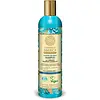What's inside
What's inside
 Key Ingredients
Key Ingredients

No key ingredients
 Benefits
Benefits

 Concerns
Concerns

 Ingredients Side-by-side
Ingredients Side-by-side

Water
Skin ConditioningSodium Coco-Sulfate
CleansingLauryl Glucoside
CleansingCocamidopropyl Betaine
CleansingSodium Chloride
MaskingPanthenol
Skin ConditioningHippophae Rhamnoides Fruit Water
SolventPhospholipids
Skin ConditioningGlycine Soja Oil
EmollientHippophae Rhamnoidesamidopropyl Betaine
CleansingHippophae Rhamnoides Fruit Oil
Skin ProtectingPineamidopropyl Betaine
CleansingArgania Spinosa Kernel Oil
EmollientLinum Usitatissimum Seed Oil
PerfumingGuar Hydroxypropyltrimonium Chloride
Skin ConditioningAbies Sibirica Needle Extract
PerfumingFlavocetraria Nivalis Extract
HumectantRhodiola Rosea Root Extract
EmollientPinus Sibirica Needle Extract
HumectantRosa Damascena Flower Water
MaskingRubus Arcticus Fruit Extract
AntioxidantBiotin/Folic Acid/Cyanocobalamin/Niacinamide/Pantothenic Acid/Pyridoxine/Riboflavin/Thiamine/Yeast Polypeptides
Skin ConditioningSodium PCA
HumectantSodium Lactate
BufferingArginine
MaskingAspartic Acid
MaskingPCA
HumectantGlycine
BufferingAlanine
MaskingSerine
MaskingValine
MaskingProline
Skin ConditioningThreonine
Isoleucine
Skin ConditioningHistidine
HumectantPhenylalanine
MaskingHydrolyzed Wheat Protein
Skin ConditioningCitric Acid
BufferingBenzyl Alcohol
PerfumingDehydroacetic Acid
PreservativeSodium Benzoate
MaskingPotassium Sorbate
PreservativeParfum
MaskingCI 15985
Cosmetic ColorantCI 16255
Cosmetic ColorantCI 19140
Cosmetic ColorantWater, Sodium Coco-Sulfate, Lauryl Glucoside, Cocamidopropyl Betaine, Sodium Chloride, Panthenol, Hippophae Rhamnoides Fruit Water, Phospholipids, Glycine Soja Oil, Hippophae Rhamnoidesamidopropyl Betaine, Hippophae Rhamnoides Fruit Oil, Pineamidopropyl Betaine, Argania Spinosa Kernel Oil, Linum Usitatissimum Seed Oil, Guar Hydroxypropyltrimonium Chloride, Abies Sibirica Needle Extract, Flavocetraria Nivalis Extract, Rhodiola Rosea Root Extract, Pinus Sibirica Needle Extract, Rosa Damascena Flower Water, Rubus Arcticus Fruit Extract, Biotin/Folic Acid/Cyanocobalamin/Niacinamide/Pantothenic Acid/Pyridoxine/Riboflavin/Thiamine/Yeast Polypeptides, Sodium PCA, Sodium Lactate, Arginine, Aspartic Acid, PCA, Glycine, Alanine, Serine, Valine, Proline, Threonine, Isoleucine, Histidine, Phenylalanine, Hydrolyzed Wheat Protein, Citric Acid, Benzyl Alcohol, Dehydroacetic Acid, Sodium Benzoate, Potassium Sorbate, Parfum, CI 15985, CI 16255, CI 19140
Ingredients Explained
These ingredients are found in both products.
Ingredients higher up in an ingredient list are typically present in a larger amount.
Lauryl Glucoside sugar- and lipid-based cleansing agent. It is created from glucose and lauryl alcohol.
This ingredient is a surfactant, making it easier to rinse oil, dirt, and other pollutants away.
A British study found lauryl glucoside to cause skin sensitivity for some people. We recommend speaking with a professional if you have concerns.
Other names for this ingredient include "Lauryl Polyglucose", "Lauryl glycoside", and "D-Glucopyranoside".
Learn more about Lauryl GlucosidePanthenol is a common ingredient that helps hydrate and soothe the skin. It is found naturally in our skin and hair.
There are two forms of panthenol: D and L.
D-panthenol is also known as dexpanthenol. Most cosmetics use dexpanthenol or a mixture of D and L-panthenol.
Panthenol is famous due to its ability to go deeper into the skin's layers. Using this ingredient has numerous pros (and no cons):
Like hyaluronic acid, panthenol is a humectant. Humectants are able to bind and hold large amounts of water to keep skin hydrated.
This ingredient works well for wound healing. It works by increasing tissue in the wound and helps close open wounds.
Once oxidized, panthenol converts to pantothenic acid. Panthothenic acid is found in all living cells.
This ingredient is also referred to as pro-vitamin B5.
Learn more about PanthenolChances are, you eat sodium chloride every day. Sodium Chloride is also known as table salt.
This ingredient has many purposes in skincare: thickener, emulsifier, and exfoliator.
You'll most likely find this ingredient in cleansers where it is used to create a gel-like texture. As an emulsifier, it also prevents ingredients from separating.
There is much debate on whether this ingredient is comedogenic. The short answer - comedogenic ratings don't tell the whole story. Learn more about comegodenic ratings here.
The concensus about this ingredient causing acne seems to be divided. Research is needed to understand if this ingredient does cause acne.
Scrubs may use salt as the primary exfoliating ingredient.
Learn more about Sodium ChlorideWater. It's the most common cosmetic ingredient of all. You'll usually see it at the top of ingredient lists, meaning that it makes up the largest part of the product.
So why is it so popular? Water most often acts as a solvent - this means that it helps dissolve other ingredients into the formulation.
You'll also recognize water as that liquid we all need to stay alive. If you see this, drink a glass of water. Stay hydrated!
Learn more about Water